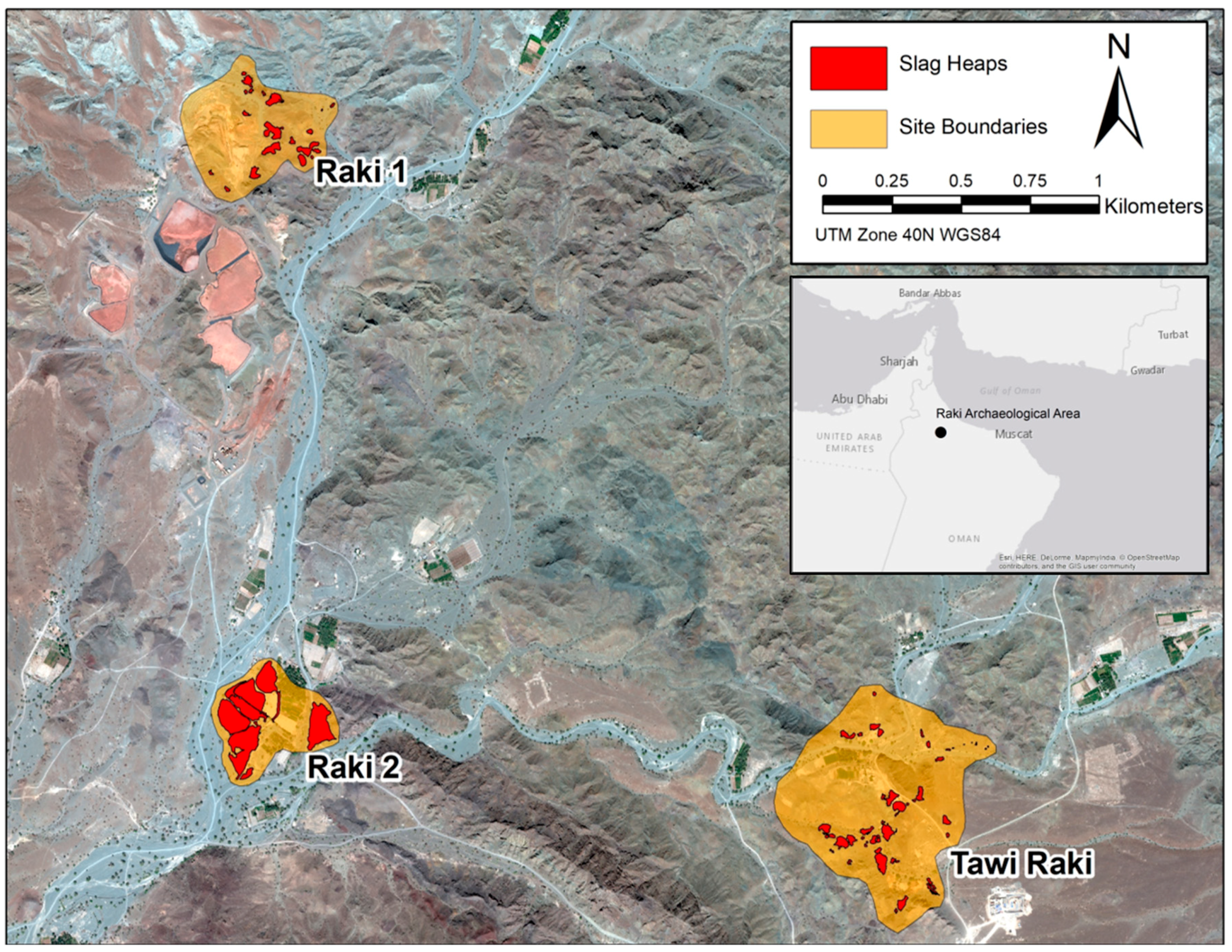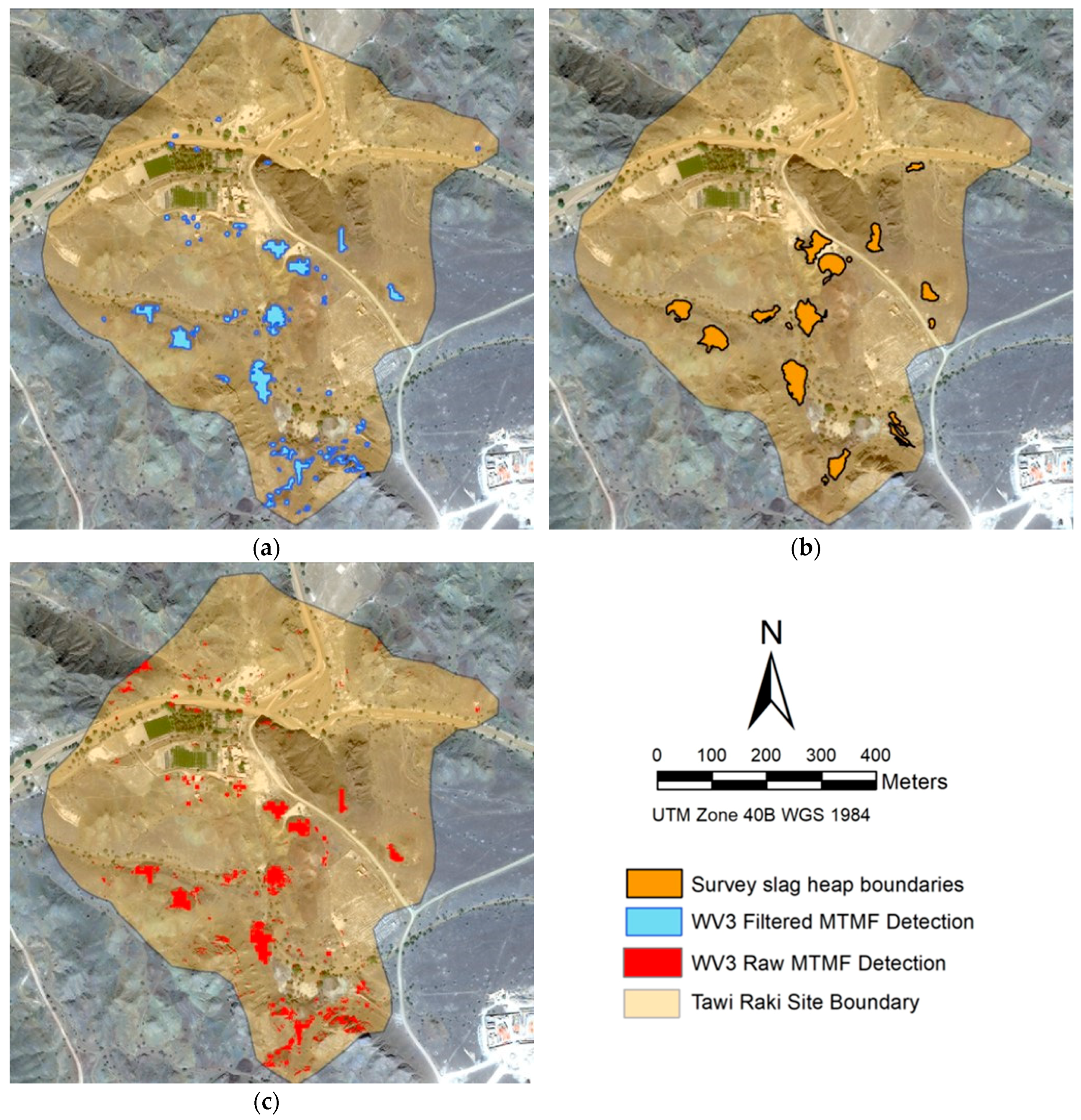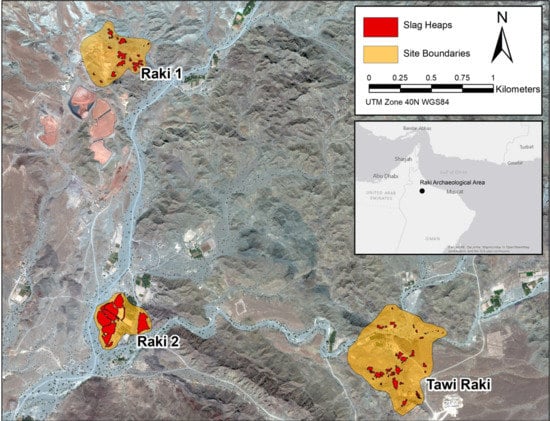Detecting and Mapping Slag Heaps at Ancient Copper Production Sites in Oman
Abstract
1. Introduction
2. Materials and Methods
2.1. Study Area
2.2. Archaeological Context
2.3. Methodology
2.3.1. Imagery and Data Processing
2.3.2. Slag Detection
2.3.3. Field Survey
2.3.4. Classification Accuracy
3. Results
3.1. Slag Detection at Raki 1
3.2. Slag Detection at Tawi Raki
4. Discussion
5. Conclusions
Author Contributions
Funding
Acknowledgments
Conflicts of Interest
References
- Pryce, T.O.; Abrams, M.J. Direct detection of Southeast Asian smelting sites by ASTER remote sensing imagery: Technical issues and future perspectives. J. Archaeol. Sci. 2010, 37, 3091–3098. [Google Scholar] [CrossRef]
- Savage, S.H.; Levy, T.E.; Jones, I.W. Prospects and problems in the use of hyperspectral imagery for archaeological remote sensing: A case study from the Faynan copper mining district, Jordan. J. Archaeol. Sci. 2012, 39, 407–420. [Google Scholar] [CrossRef]
- Savage, S.H.; Levy, T.E.; Jones, I.W. Archaeological remote sensing in Jordan’s Faynan copper mining district with hyperspectral imagery. In Mapping Archaeological Landscapes from Space; Harrower, M.J., Comer, D.C., Eds.; Springer: New York, NY, USA, 2013; pp. 97–110. [Google Scholar]
- Dumitru, I.A.; Harrower, M.J. Mapping Ancient Production and Trade of copper from Oman and Obsidian from Ethiopia. In The Read Sea and the Persian Gulf from Late Prehistory to Early Modernity; Manzo, A., Zazzaro, C., DeFalco, D.J., Eds.; Brill: Leiden, The Netherlands, 2018; pp. 74–94. [Google Scholar]
- Dumitru, I.A.; Harrower, M.J. From Rural Collectibles to Global Commodities: Copper from Oman and Obsidian from Ethiopia. In Globalization in Prehistory: Contact, Exchange, and the “People Without History”; Boivin, N., Frachetti, M., Eds.; Cambridge University Press: Cambridge, UK, 2018; pp. 232–262. [Google Scholar]
- Digital Globe Inc. WorldView-3 Data Sheet. Available online: https://dgv4-cms-production.s3.amazonaws.com/uploads/document/file/128/DG2017_WorldView-3_DS.pdf (accessed on 10 September 2019).
- Berthoud, T.; Besenval, R.; Cleuziou, S.; Drin, N. Les anciennes mines de cuivre du sultanat d’Oman. In Rech. Copp. Sur Programme; Pierre and Marie Curie University: Paris, France, 1978; Volume 442. [Google Scholar]
- Weisgerber, G. Evidence of Ancient Mining Sites in Oman: A Preliminary Report. J. Oman Stud. 1978, 4, 15–28. [Google Scholar]
- Yule, P.; Weisgerber, G. Die 14. Deutsche Archäologische Oman-Expedition 1995. Mitt. Dtsch. Oreint-Ges. 1996, 128, 135–155. [Google Scholar]
- Weisgerber, G.; Yule, P. Preliminary Report of the 1996 Season of Excavation in the Sultanate of Oman. In Studies in the Archaeology of the Sultanate of Oman; Yule, P., Ed.; Verlag Marie Leidorf: Rahden, Germany, 1999; pp. 97–117. [Google Scholar]
- Hauptmann, A. 5000 Jahre Kupfer in Oman. Bd. 1: Die Entwicklung der Kupfermetallurgie vom 3. Jahrtausend bis zum Neuzeit; Deutsche Bergbau-Museum: Bochum, Germany, 1985. [Google Scholar]
- Dilek, Y.; Furnes, H. Structure and geochemistry of Tethyan ophiolites and their petrogenesis in subduction rollback systems. Lithos 2009, 113, 1–20. [Google Scholar] [CrossRef]
- Hacker, B.R.; Mosenfelder, J.L.; Gnos, E. Rapid emplacement of the Oman ophiolite: Thermal and geochronologic constraints. Tectonics 1996, 15, 1230–1247. [Google Scholar] [CrossRef]
- Searle, M.; Cox, J. Tectonic setting, origin, and obduction of the Oman ophiolite. Geol. Soc. Am. Bull. 1999, 111, 104–122. [Google Scholar] [CrossRef]
- Rioux, M.; Bowring, S.; Kelemen, P.; Gordon, S.; Miller, R.; Dudás, F. Tectonic development of the Samail ophiolite: High-precision U-Pb zircon geochronology and Sm-Nd isotopic constraints on crustal growth and emplacement: Tectonic History of the Samail Ophiolite. J. Geophys. Res. Solid Earth 2013, 118, 2085–2101. [Google Scholar] [CrossRef]
- Nicolas, A.; Boudier, F.; Ildefonse, B. Evidence from the Oman ophiolite for active mantle upwelling beneath a fast-spreading ridge. Nature 1994, 370, 51–53. [Google Scholar] [CrossRef]
- Lippard, S.J.; Shelton, A.W.; Gass, I.G. The Ophiolite of Northern Oman; Geological Society Memoir; Geological Society: London, UK, 1986. [Google Scholar]
- Gilgen, S.A.; Diamond, L.W.; Mercolli, I.; Al-Tobi, K.; Maidment, D.W.; Close, R.; Al-Towaya, A. Volcanostratigraphic Controls on the Occurrence of Massive Sulfide Deposits in the Semail Ophiolite, Oman. Econ. Geol. 2014, 109, 1585–1610. [Google Scholar] [CrossRef]
- Gilgen, S.A.; Diamond, L.W.; Mercolli, I. Sub-seafloor epidosite alteration: Timing, depth and stratigraphic distribution in the Semail ophiolite, Oman. Lithos 2016, 260, 191–210. [Google Scholar] [CrossRef]
- Bechennec, E.; Roger, J.; Le Metour, J.; Wyns, R.; Cheyrel, S. Geological Map of Ibri: Sheet NF 40–02; Ministry of Petroleum and Minerals: Muscat, Oman, 1992.
- Villey, M.; Bechennec, E.; Beurrier, M.; Le Metour, J.; Rabu, D. Geological Map of Yanqul, sheet NF 40-2C; Ministry of Petroleum and Minerals: Muscat, Oman, 1986.
- Alabaster, T.; Pearce, J.A.; Malpas, J. The volcanic stratigraphy and petrogenesis of the Oman ophiolite complex. Contrib. Mineral. Petrol. 1982, 81, 168–183. [Google Scholar] [CrossRef]
- Robertson, A.H.F.; Searle, M.P.; Ries, A.C. (Eds.) The Geology and Tectonics of the Oman Region; Geological Society: London, UK, 1990; Volume 49. [Google Scholar]
- Partington, G. Developing Models using GIS to Assess Geological and Economic Risk: An Example from Mineral Exploration in Oman for VMS Copper Gold Mineralisation. In Proceedings of the Tenth Biennial SGA Meeting, Smart Science for Exploration and Mining, Townsville, Australia, 17–20 August 2009; Society for Geology Applied to Mineral Deposits: Townsville, Australia, 2009; pp. 836–838. [Google Scholar]
- Giardino, C. Magan—The Land of Copper: Prehistoric Metallurgy of Oman; Ministry of Heritage and Culture: Muscat, Oman, 2017.
- Weeks, L. Early Metallurgy of the Persian Gulf; Brill: Lieden, The Netherlands, 2003. [Google Scholar]
- Schmidt, C.; Döpper, S. The Hafit Period at Al-Khashbah, Sultanate of Oman: Results of Four Years of Excavations and Material Studies. Proc. Semin. Arab. Stud. 2019, 29, 265–274. [Google Scholar]
- Goetller, G.W.; Firth, N.; Huston, C.C. A Preliminary Discussion of Ancient Mining in the Sultanate of Oman. J. Oman Stud. 1976, 2, 43–56. [Google Scholar]
- Hasting, A.; Humphries, J.H.; Meadow, R.H. Oman in the third millennium BCE. J. Oman Stud. 1975, 1, 9–56. [Google Scholar]
- Tosi, M. Notes on the distribution and exploitation of natural resources in ancient Oman. J. Oman Stud. 1975, 1, 187–206. [Google Scholar]
- Hauptmann, A.; Weisgerber, G.; Bachmann, H.G. The Beginning of the Use of Metals and Alloys; Maddin, R., Ed.; MIT Press: Cambridge, MA, USA, 1988. [Google Scholar]
- Prange, M.K. 5000 Jahre Kupfer im Oman: Bd. II Vergleichende Untersuchungen zur Charakterisierung des omanischen Kupfers mittels chemischer und isotopoischer Analysenmethoden; Deutsche Bergbau-Museum: Bochum, Germany, 2001. [Google Scholar]
- Weisgerber, G. Beobachten zum alten Kupfergebau in Sultanat Oman. Anschnitt 1977, 29, 189–211. [Google Scholar]
- Weisgerber, G. und Kupfer in Oman. Anschnitt 1980, 32, 62–110. [Google Scholar]
- Weisgerber, G. Archäologische und archäometallurgische Untersuchungen in Oman. Allg. Vgl. Archäol. 1980, 2, 67–90. [Google Scholar]
- Weisgerber, G. Mehr als Kupfer in Oman. Der Anschnitt. Anschnitt 1981, 33, 174–263. [Google Scholar]
- Begemann, F.; Hauptmann, A.; Schmitt-Strecker, S.; Weisgerber, G. Lead Isotope and Chemical Signature of Copper from Oman and Its Occurence in Mesopotamia and Sites on the Arabian Coast. Arab. Archaeol. Epigr. 2010, 21, 135–169. [Google Scholar] [CrossRef]
- Weisgerber, G. Patterns of Early Islamic Metallurgy in Oman. Proc. Semin. Arab. Stud. 1980, 10, 115–129. [Google Scholar]
- Weisgerber, G. Copper Production during the Third Millennium B.C. in Oman and the Question of Makkan. J. Oman Stud. 1983, 6, 269–276. [Google Scholar]
- Coleman, R.G.; Edgar, H.B. Mineral deposits and Geology of Northern Oman as of 1974; United States Geologic Survey: Reston, VA, USA, 1981.
- Weisgerber, G. Archaeological Evidence of Copper Exploitation at ‘Arja. J. Oman Stud. 1987, 9, 145–172. [Google Scholar]
- Harris Geospatial Solutions Inc. ENVI v 5.3 Fast Line-of-Sight Atmospheric Analysis of Hypercubes; Harris Geospatial Solutions Inc.: Broomfield, CO, USA, 2015. [Google Scholar]
- Adler-Golden, S.M.; Matthew, M.W.; Bernstein, L.S.; Levine, R.Y.; Berk, A.; Richtsmeier, S.C.; Acharya, P.K.; Anderson, G.P.; Felde, J.W.; Gardner, J.A.; et al. Atmospheric Correction for Shortwave Spectral Imagery Based on MODTRAN4. In Proceedings of SPIE Imaging Spectrometry V; SPIE: Denver, CO, USA, 1999; Volume 3753, pp. 61–69. [Google Scholar]
- Green, A.A.; Berman, M.; Switzer, P.; Craig, M.D. A transformation for ordering multispectral data in terms of image quality with implications for noise removal. IEEE Trans. Geosci. Remote Sens. 1988, 26, 65–74. [Google Scholar] [CrossRef]
- Mundt, J.T.; Street, N.G.; Streutker, D.R.; Glenn, N.F. Partial unmixing of hyperspectral imagery: Theory and methods. In Proceedings of the American Society of Photogrammetry and Remote Sensing; ASPRS: Tampa, FL, USA, 2007; Volume 2007. [Google Scholar]
- Boardman, J.W. Leveraging the high dimensionality of AVIRIS data for improved sub-pixel target unmixing and rejection of false positives: Mixture tuned matched filtering. In Summaries of the Seventh JPL Airborne Geoscience Workshop; NASA Jet Propulsion Laboratory: Pasadena, CA, USA, 1998; Volume 97, pp. 55–56. [Google Scholar]
- Kruse, F.A.; Boardman, J.W.; Hunnington, J.F. Comparison of airborne hyperspectral data and EO-1 Hyperion for mineral mapping. IEEE Trans. Geosci. Remote Sens. 2003, 41, 1388–1400. [Google Scholar] [CrossRef]
- Goodarzi Mehr, S.; Ahadnejad, V.; Abbaspour, R.A.; Hamzeh, M. Using the mixture-tuned matched filtering method for lithological mapping with Landsat TM5 images. Int. J. Remote Sens. 2013, 34, 8803–8816. [Google Scholar] [CrossRef]
- Kruse, F.A.; Baugh, W.M.; Perry, S.L. Validation of DigitalGlobe WorldView-3 Earth imaging satellite shortwave infrared bands for mineral mapping. J. Appl. Remote Sens. 2015, 9, 096044. [Google Scholar] [CrossRef]
- Boardman, J.W.; Kruse, F.A. Analysis of Imaging Spectrometer Data Using N-Dimensional Geometry and a Mixture-Tuned Matched Filtering Approach. IEEE Trans. Geosci. Remote Sens. 2011, 49, 4138–4152. [Google Scholar] [CrossRef]
- Boardman, J.W. Automated Spectral Unmixing of AVIRIS Data Using Convex Geometry Concepts. In Proceedings of the Summaries of the Fourth JPL Airborne Geoscience Workshop, Pasadena, CA, USA, 25–29 October 1993; NASA Jet Propulsion Laboratory: Pasadena, CA, USA, 1993; Volume 1, pp. 11–14. [Google Scholar]
- Clark, R.N. Spectroscopy of Rocks and Minerals, and Principles of Spectroscopy. In Manual of Remote Sensing; John Wiley & Sons: New York, NY, USA, 1999; Volume 3, pp. 3–58. [Google Scholar]
- Giles, P. Remote Sensing and Cast Shadows in Mountainous Terrain. Photogramm. Eng. Remote Sens. 2001, 67, 833–839. [Google Scholar]
- Shahtahmassebi, A.; Yang, N.; Wang, K.; Moore, N.; Shen, Z. Review of shadow detection and de-shadowing methods in remote sensing. Chin. Geogr. Sci. 2013, 23, 403–420. [Google Scholar] [CrossRef]
- Heiden, U.; Segl, K.; Roessner, S.; Kaufmann, H. Determination and Verification of Robust Spectral Features for an Automated Classification of Sealed Urban Surfaces. In Proceedings of the 4th EARSeL Workshop on Imaging Spectroscopy. New quality in environmental studies, EARSel and Warsaw University, Warsaw, PL, USA, 27–29 April 2005. [Google Scholar]
- Kruse, F.A.; Lefkoff, A.B.; Boardman, J.W.; Heidebrecht, K.B.; Shapiro, A.T.; Barloon, P.F.; Goetz, A.F.H. The spectral image processing system (SIPS)—Interactive visualization and analysis of imaging spectrometer data. Remote Sens. Environ. 1993, 44, 145–163. [Google Scholar] [CrossRef]
- Clark, R.N.; Swayze, G.; Heidebrecht, K.B.; Goetz, A.F.H.; Green, R.O. Comparison of Methods for Calibrating AVIRIS Data to Ground Reflectance; Jet Propulsion Laboratory: Pasadena, CA, USA, 1993; pp. 35–36. [Google Scholar]
- Yuhas, R.H.; Goetz, A.F.H.; Boardman, J.W. Discrimination among semi-arid landscape endmembers using the spectral angle mapper (SAM) algorithm. In Proceedings of the Summaries of the Third Annual JPL Airborne Geoscience Workshop, Jet Propulsion Laboratory, Pasadena, CA, USA, 1–5 June 1992; Volume 1. [Google Scholar]
- Ranjbar, H.; Honarmand, M.; Moezifar, Z. Application of the Crosta technique for porphyry copper alteration mapping, using ETM+ data in the southern part of the Iranian volcanic sedimentary belt. J. Asian Earth Sci. 2004, 24, 237–243. [Google Scholar] [CrossRef]









| Presence/Absence Accuracy (a) | ||||
| Filtered Detection Results | 79% | Unfiltered Detection Results | 84% | |
| Site Specific Accuracy (b) | ||||
| Field Reference Data | ||||
| Slag | Background | |||
| WV3 Detection Results | Slag | 37 | 26 | |
| Background | 47 | 890 | ||
| Class Name | Commission (%) | Omission (%) | User’s Accuracy | Producer’s Accuracy |
| Slag | 41% | 56% | 59% | 44% |
| Background | 5% | 3% | 95% | 97% |
| Presence/Absence Accuracy (a) | ||||
| Filtered Detection Results | 75% | Unfiltered Detection Results | 80% | |
| Site Specific Accuracy (b) | ||||
| Field Reference Data | ||||
| Slag | Background | |||
| WV3 Detection Results | Slag | 17 | 9 | |
| Background | 16 | 958 | ||
| Class Name | Commission (%) | Omission (%) | User’s Accuracy | Producer’s Accuracy |
| Slag | 35% | 49% | 65% | 51% |
| Background | 2% | 1% | 98% | 99% |
© 2019 by the authors. Licensee MDPI, Basel, Switzerland. This article is an open access article distributed under the terms and conditions of the Creative Commons Attribution (CC BY) license (http://creativecommons.org/licenses/by/4.0/).
Share and Cite
Sivitskis, A.J.; Lehner, J.W.; Harrower, M.J.; Dumitru, I.A.; Paulsen, P.E.; Nathan, S.; Viete, D.R.; Al-Jabri, S.; Helwing, B.; Wiig, F.; et al. Detecting and Mapping Slag Heaps at Ancient Copper Production Sites in Oman. Remote Sens. 2019, 11, 3014. https://doi.org/10.3390/rs11243014
Sivitskis AJ, Lehner JW, Harrower MJ, Dumitru IA, Paulsen PE, Nathan S, Viete DR, Al-Jabri S, Helwing B, Wiig F, et al. Detecting and Mapping Slag Heaps at Ancient Copper Production Sites in Oman. Remote Sensing. 2019; 11(24):3014. https://doi.org/10.3390/rs11243014
Chicago/Turabian StyleSivitskis, Alexander J., Joseph W. Lehner, Michael J. Harrower, Ioana A. Dumitru, Paige E. Paulsen, Smiti Nathan, Daniel R. Viete, Suleiman Al-Jabri, Barbara Helwing, Frances Wiig, and et al. 2019. "Detecting and Mapping Slag Heaps at Ancient Copper Production Sites in Oman" Remote Sensing 11, no. 24: 3014. https://doi.org/10.3390/rs11243014
APA StyleSivitskis, A. J., Lehner, J. W., Harrower, M. J., Dumitru, I. A., Paulsen, P. E., Nathan, S., Viete, D. R., Al-Jabri, S., Helwing, B., Wiig, F., Moraetis, D., & Pracejus, B. (2019). Detecting and Mapping Slag Heaps at Ancient Copper Production Sites in Oman. Remote Sensing, 11(24), 3014. https://doi.org/10.3390/rs11243014







